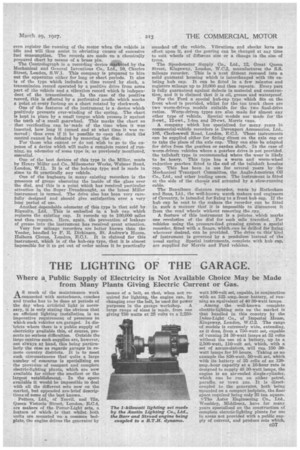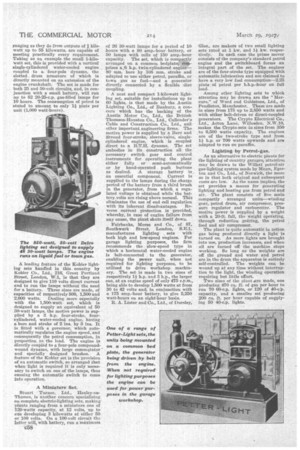THE LIGHTING OF THE GARAGE.
Page 127

Page 128

If you've noticed an error in this article please click here to report it so we can fix it.
Where a. Public Supply of Electricity is Not Available Choice May be from Many Plants Giving Electric Current or Gas.
AS much of the maintenance work connected with motorbuses, coaches and trucks has to be done at periods of the day when artificial light is necessary, it is only stating the obvious that an efficient lighting installation is an imperative requirement of premises in which such vehicles are garaged. In districts where there is a puhlie supply of electricity available this, of course, presents no serious difficulties. Outside the large centres such supplies are, however, not always at hand, this being particularly the case as regards garages in remote country districts. It is to meet such circumstances that quite a large number of concerns is specializing on the provision of compact and complete electric-lighting plants, which are now available for either the smallest or the largest establishment. In the space available it would be impossible to deal with all the different gets now on the market, but appended are-brief descriptions of some of the best known.
Petters, Ltd., of Yeovil, and 75n, Queen Victoria Street, London, E.C.4, are makers of the Petter-Light sets, a feature of which is that whilst both units are mounted -on a common bedplate, the engine drives the generator by
means of a belt, so that, when not required for lighting, the engine can, by changing over the belt, be used for power purposes in the garage workshop. A large range of sizes is made, from one giving 750 watts at 25 volts to a 2,250 watt 100-volt set, capable, in conjunction with an 125 amp.-hour battery, of running an equivalent of 40 30-watt lamps.
Among the well-known complete electric-lighting sets on the market is that handled in this country by the Delco-Light Co., of Imperial House, Kingsway, London, WO.2. The range of models is extremely wide, extending, as it does, from a 750-watt set, capable of running 24 30-watt lamps at 32 volts without the use of, a battery, up to a 2,500-watt, 110-volt set, which, with a set of accumulators, will run 150 30-watt lamps for 10 hours. Taking as an example the 550-watt, 50-volt set, which with its battery of 25 cells of an 120ampahour capacity at a 10-hour rate is designed to supply 48 30-watt lamps, the engine is an air-cooled gingle-cylinder, -which can be run on either petrol, paraffin or town gas. It is directcoupled to the generator, both being mounted on a compact bedplate, the floor space required being only 25 ins, square. nThe Aster Engineering Co., Ltd., Wembley, 141iddleset, have for many years specialized on the construction of complete electric-lighting plants for use in areas not provided with a public supply of current, and produce sets which, ranging as they do from outputs of f kilowatt up to 55 kilowatts, are capable of meeting practically every requirement. Taking as an example the small 1-kilowatt set, this is provided with a vertical single-cylindered water-cooled engine coupled to afour-pole dynamo, the slotted drum armature of which is directly mounted on an extension of the engine crankshaft. The set is made for both 25 and 50-volt circuits, and, in conjunction with a small battery, will run up to 82 20-25-e.p. gas-filled lamps for 10 hours. The consumption of petrol is stated to amount to only l pints per unit (1,000 watt-hours).
A leading feature of the Kohler lighting sets handled in this. country by Kohler Co., Ltd., 216, Great Portland Street, London, W.1, is that they are designed to give 110 volts direct current and to run the lamps without the need for a battery. Three sizes are made, of capacities of respectively SOO, 1,500 and 2,000 watts. Dealing more especially with the 1,500-watt set, which is designed to supply an equivalent of 50 80-watt lamps, the motive power is supplied by a 3 11.p. four-stroke, fourcylindered, water-cooled engine, having a bore and stroke of 2 ins. by 3 ins. It is fitted with a governor, which automatically regulates the engine speed, and consequently the petrol consumption, in proportion to the load. The engine is directly coupled to a four-pole compoundwound dynamo, with large commutator ' and specially designed brushes. A feature of the Kohler set is the provision of an automatic switch, so arranged that when -light is required it is only necessary to switch on one of the lamps, thus causing the automatic switch to come into operation.
A Miniature Set.
Stuart Turner, Ltd., Henley-onThames, is another concern specializing on complete electric-lighting sets, making plants ranging from a miniature one of 120-watts capacity, at 12 volts, up to one developing 3 kilowatts at either 50 or 100 volts. On a 100-volt circuit the latter will with battery, run a maximum
of 26 30-watt lamps for a period of 10 hours with a 80 amp.-hour battery, or 50 lamps with cells of 150 amp.-hour capacity. The set, which is compactly arranged on a common hedplate, prises a.6 h.p. twin-cylindered engine--80 mm. bore by 108 ram_ stroke and adapted to use either petrol, paraffin, or town gas as fuel—and a generator directly connected by a flexible disc coupling.
A neat and compact 1-kilowatt lighting, set, suitable for installations up to 60 lights, is that made by the Austin Lighting Co., Ltd., of Banbury, a concern which has the backing of the Austin Motor Co., Ltd., the British Thomson-Houston Co., Ltd., Callender's Cable and Construction Co„ Ltd., arid other important engineering Arms. The motive power is supplied by a Barr and Stroud four-stroke, sleeve-valve, singlecylindered engine, which is coupled direct to a B.T.H. dynamo. The set embodies in its construction all the necessary switch gear and control instruments for operating the plant either fully or semi-automatically or by hand-operated . push buttons as desired. A storage battery is an essential component. Current is supplied to the lamps during the charge period of the battery from a third brush in the generator, from which a regulated voltage is obtained while the battery volts are rising above normal. This eliminates the use of end cell regulation with its inherent disadvantages. Reverse current protection is provided, whereby, in cast of engine failure from any cause, the plant shuts itself down.
Fairbanks, Morse and Co., of 87, Southwark Street, London, S.E.1,
manufactures lighting , sets with both high and low-speed 'engines. For garage lighting purposes, the firm recommends the slow-speed type in which a horizontal water-cooled engine is belt-connected to the generator, enabling the power unit, when not required for lighting purposes, to be utilized to drive workshop machinery. The set is made in two sizes of respectively. 34 h.p. and 3 h.p., the larger one, at an engine speed of only 475 r.p.m., being able to develop 1,500 watts at from 30 to 42 volts and, in conjunction with a 175 amp.-hour battery, to give 5,250 watt-hours on an eight-hour basis.
It. A. Lister and Co., Ltd., of Dursley, Glos., are makers of two small lighting sets rated at 1 kw. and 1* kw. respectively. In each case the prime mover consists of the company's standard petrol engine and the switchboard forms an integral part of the set. The engines are of the four-stroke type equipped with automatic lubrication and are claimed to have a very low fuel consumption-2.25 pints of petrol per b.h.p.-hour on full load.
Amongother lighting sets to which attention may be drawn are the " Mercure," of Ward and Goldstone, Ltd., of Pendleton, Manchester. These are made in sizes from 175 up to 2,850 watts and with either belt-driven or direct-coupled generators. The Crypt° Electrical Co., Ltd., Acton Lane, Willesden, N.W.10, makes the Crypto sets in sizes from 350 to 6,500 watts capacity. The engines are of the two-stroke type and from 1i h.p. or 700 watts upwards and are adapted to run on paraffin.
Lighting by Petrol-gas.
As an alternative to electric plants for the lighting of -country garages, attention may be drawn to the Willett petrol-air gas-lighting system made by Mann, Egerton and Co„ Ltd., of Norwich, the more so in that both original and subsequent costs are low. As the name implies, the set provides a means for generating lighting and heating gas from petrol and air. The plant consists of five main compactly arranged units—winding gear, petrol drum, air compressor, pressure regulator and carburetter. The motive power is supplied by a weight with a 20-ft. fail, the weight Operating, through reduction gearing, the petrol feed and air compressor.
The plant is quite automatic in action gas being produced directly a light is turned on. As more lights are brought into use, production increases, and when all are turned off the machine stops working. So long as the weights are off the ground and water and petrol are in the drum the apparatus is entirely self-controlled. The weights can be wound up at any time without interruption to the light, the winding operation requiring but little effort.
Two sizes of the plentiare made, one producing 470 cu. ft. of gas per hour to run '70 60-c.p. lights, or 120 of 40-c.p. capacity, and a smaller set producing 200 cu, ft. per hour capable of supplying 50 40-c.p. lights.












































































































































































